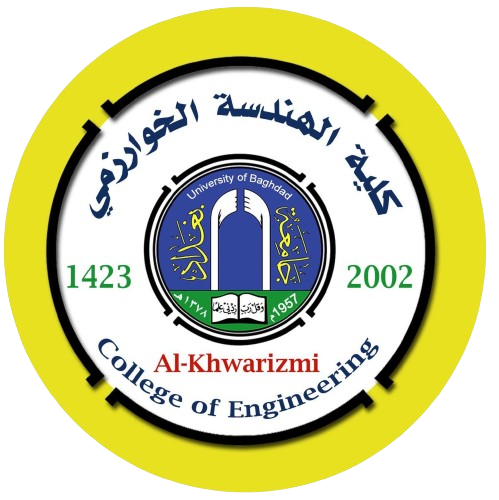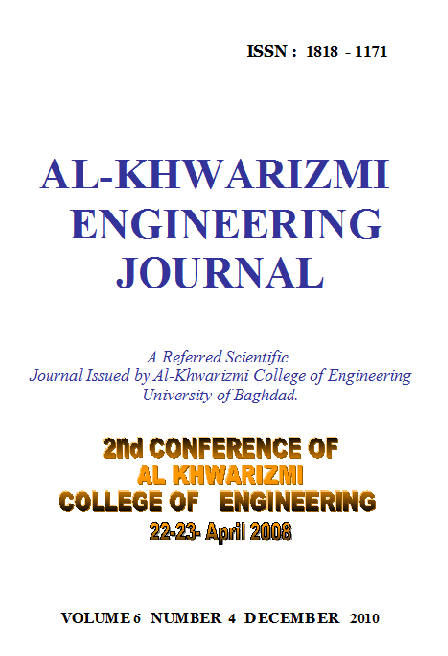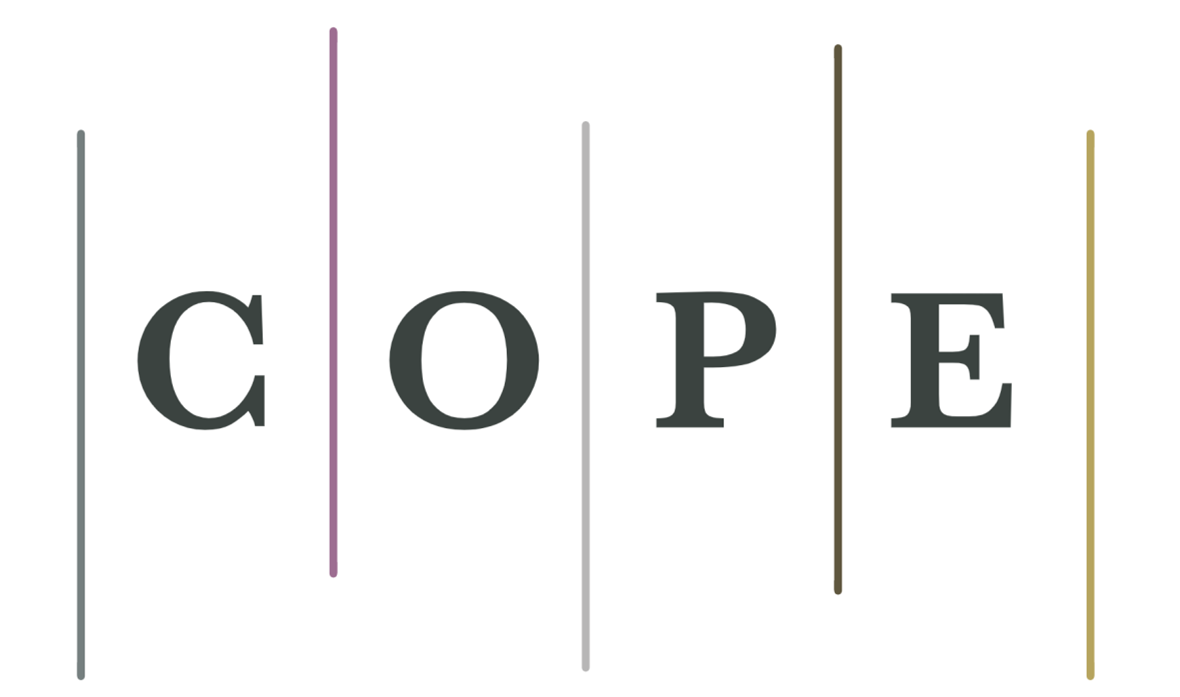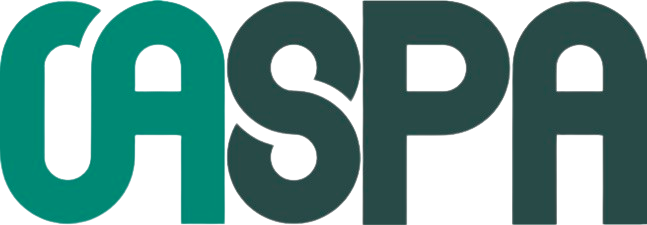Improvement of Surface Roughness Quality for Stainless Steel 420 Plate Using Magnetic Abrasive Finishing Method
الملخص
تم في هذا البحث اجراء دراسة عملية لتحسين جودة السطح من حيث الخشونة للصلب المقاوم نوع 420 باستخدام طريقة الحث المغناطيسي وذلك بدراسة تاثير أربعة عوامل تشغيلية وهي:1- الفراغ بين القطب المحث والمشغولة و2- التيار و3- سرعة التغذية و 4- أشواط التغذية. تم تصميم وتصنيع محاث كهرومغناطيسي ذو ملف دوار للاستخدام في التجارب. تم استخدام مسحوق تنعيم (33% حديد و 67 % كوارتز) بنعومة (µm 250 ) واضافة الزيت نوع SAE 20W كمادة رابطة بين مكونات المسحوق . أستخدمت طريقة Taguchi لتصميم منظومة التجارب ومن ثم ايجاد القيم المثلى لعوامل التشغيل حيث تم ايجاد معادلة تجريبية تمثل العلاقة بين نسبة التغيير في خشونة السطح والعوامل التشغيلية المدروسة.
التنزيلات
المراجع
[2] Geeng-Wei Chang, Biing-Hwa, and Yan, Rong-Tzong Hsu, “Study on cylindrical magnetic abrasive finishing using unbounded magnetic abrasives”, International Journal of Machine Tools & Manufacture, Vol.42 (2002), pp. 575–583.
[3] T. Mori, K. Hirota, and Y. Kawashima, “Clarification of magnetic abrasive finishing mechanism”, Journal of Materials Processing Technology, Vols.143-144 (2003), pp. 682–686.
[4] 4- V. S. Maiboroda and E. A. Khomenko, “Tribotechnical characteristics of ferroabrasive powders in magnetic-abrasion machining”, Journal of Powder Metallurgy and Metal Ceramics, Vol.42 (2003), pp. 9-10.
[5] Dhirendra K. Singh, V.K. Jain, and V. Raghuram., “Parametric study of magnetic abrasive finishing process”, Journal of Materials Processing Technology, Vol.149 (2004), pp. 22–29.
[6] Y. M. Baron, S. L. Ko, and J. I. Park, “Characterization of the magnetic abrasive finishing method and its application to deburring”, Key Engineering Materials Vols.291-292 (2005), pp. 291-296.
[7] Yan Wang, and Dejin Hu, ”Study on the inner surface finishing of tubing by magnetic abrasive finishing”, International Journal of Machine Tools & Manufacture, Vol.45 (2005), pp. 43–49.
[8] O. V. Stepanova, I. V. Uvarova, V. P. Smirnov, I. I. Timofeeva, and A. A. Rogozinskaya, “Effect of magnetic abrasive finishing on the chemical and phase composition of Tic coating on VK8 alloy”, Journal of Powder Metallurgy and Metal Ceramics, Vol.44 (2005), pp. 9-10.
[9] P. I. Yascheritsin, L. E. Sergeev, and M. I. Sidorenko, “The comparative appraisal of quality characteristics of holes after different finishing methods”, Journal of Advanced Performance Materials, Vol.4 (1997), pp. 337–347.
[10] K. A. Gogaev, V. V. Nepomnyashchii, T. V. Mosina, I. P. Neshpor, and M. Leonowicz, “Special features of the magnetic abrasive machining”, Journal of Refractories and Industrial Ceramics, Vol.47, No.1 ( 2006), pp. 46-47.
[11] Ching-Tien Lin, Lieh-Dai Yang, and Han-Ming Chow, “Study of magnetic abrasive finishing in free-form surface operations using the Taguchi method”, International Journal of Advanced Manufacturing Technology, (2006).
[12] Dhirendra K. Singh, V. K. Jain, and V. Raghuram, “Experimental investigations into forces acting during a magnetic abrasive finishing process”, International Journal of Advanced Manufacturing Technology Vol.30 (2006), pp. 652–662.
[13] L. Ko, Yu M. Baron, and J.I. Park,”Micro deburring for precision parts using magnetic abrasive finishing method”, Journal of Materials Processing Technology Vols.187–188 (2007), pp. 19–25.
منشور
إصدار
القسم
الرخصة
حقوق الطبع والنشر: يحتفظ مؤلفو الوصول المفتوح بحقوق الطبع والنشر لاعمالهم، ويتم توزيع جميع مقالات الوصول المفتوح بموجب شروط ترخيص Creative Commons Attribution License، والتي تسمح بالاستخدام غير المقيد والتوزيع والاستنساخ في أي وسيط، بشرط ذكر العمل الأصلي بشكل صحيح. إن استخدام الأسماء الوصفیة العامة، والأسماء التجاریة، والعلامات التجاریة، وما إلی ذلك في ھذا المنشور، حتی وإن لم یتم تحدیدھ بشکل محدد، لا یعني أن ھذه الأسماء غیر محمیة بموجب القوانین واللوائح ذات الصلة. في حين يعتقد أن المشورة والمعلومات في هذه المجلة صحيحة ودقيقة في تاريخ صحتها، لا يمكن للمؤلفين والمحررين ولا الناشر قبول أي مسؤولية قانونية عن أي أخطاء أو سهو قد يتم. لا يقدم الناشر أي ضمان، صريح أو ضمني، فيما يتعلق بالمواد الواردة في هذه الوثيقة.











